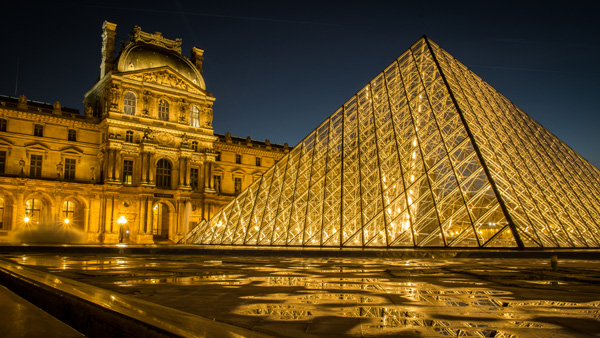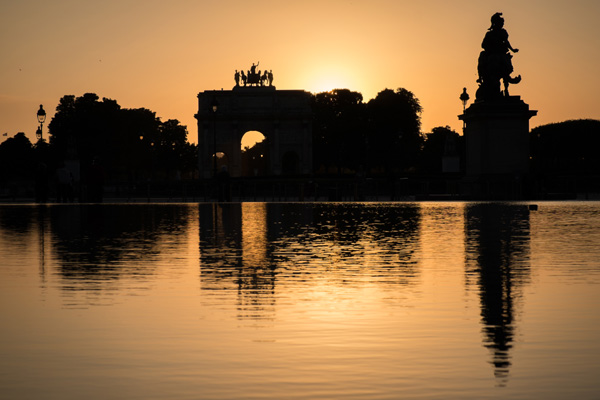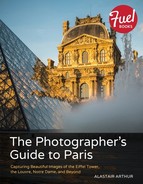Louvre
Whatever you think of the Louvre Pyramids in the Louvre Palace’s main courtyard, Paris shows that it isn’t afraid to mix the ancient with the modern. The main courtyards and connecting archways are some of my favorite places to photograph in Paris. The Louvre Museum is by the river and close to Notre Dame; make sure it’s on your list.

Fujifilm X-E1, 18mm, ISO 200, 30s, f/18
Visitor Information
The Louvre is huge. It’s one of the largest museums in the world, covering more than 650,000 square feet (60,000 square meters). Photography is allowed inside.
The building itself is called the Palais du Louvre (Louvre Palace), and it was originally a 12th-century fortress. Check the official Louvre site for the current opening hours.
Getting There
The Louvre is in the 1st arrondissement, in the center of the city. The nearest Metro station is Palais Royal–Musée du Louvre, on lines 1 and 7. The Musée d'Orsay station on RER line C is just across the river.
When to Go
Try to be there for dusk. The U shape of the Louvre Palace means that shadows fall early across much of the inner sides of the building, but when the lights are turned on through blue hour and into the night, it looks spectacular.
Viewpoints
The museum building has so many details and patterns while the pyramids are all angles and reflections. Add in the fountains, archways, musicians and other visitors, and you’re spoiled for choice.
Palace
From the central pyramid, archways lead through the palace to the north and east and are well worth exploring. To the east is another courtyard with more impressive architecture and far fewer visitors.

Fujifilm X-E1, 18mm, ISO 400, 1/100s, f/10
Archways
The archways themselves can provide some good framing and options to create silhouettes of other visitors.
Pyramids
The palace, entrance pyramid, surrounding pyramids, and fountains are all well lit, and the metal structures and reflections in the pyramids create plenty of options for some good long-exposure shots at night.
Look out for reflections in the water and the glass for some interesting effects, and use a small aperture at night to get the starburst effect from the streetlights.

Fujifilm X-E1, 18mm, ISO 800, 1/500s, f/4
Inside
Non-flash photography is allowed in the Louvre so you can actually take some shots of the “Mona Lisa.” It’s better, though, to take some shots of visitors with iPhones taking selfies with the “Mona Lisa.”
Looking West
Immediately to the west and before the Tuileries Gardens is another arch, the Arc du Carousel. The views to the west can be especially pretty around dusk, with dust blown or kicked up from the Tuileries Gardens. The Arc du Carousel is also on the Historical Axis, so you can line it up with the obelisk at Place de la Concorde and the Arc de Triomphe in the distance.

Fujifilm X-E1, 55mm, ISO 200, 1/250s, f/11
Nearby Sights
The Tuileries Gardens provides the chance to watch Parisians and visitors alike taking a moment, or a few hours, to relax. The west end of the gardens features elevated areas that can provide good shots of Place de la Concorde and, when it’s in place, the 195-foot (60-meter) tall Roue de Paris Ferris wheel. In the west area of the gardens you’ll spot a small lake with a large golden globe at its center that can provide a good image.
The gardens and the Louvre are bounded by a river to the south and rue de Rivoli to the north. Île de la Cité, a natural island in the Seine river, is just to the west. The western point of the island is an ideal spot for portraits. Angelina’s on rue de Rivoli is a well-known and popular tearoom that provides ridiculously rich and sumptuous desserts and drinks.
